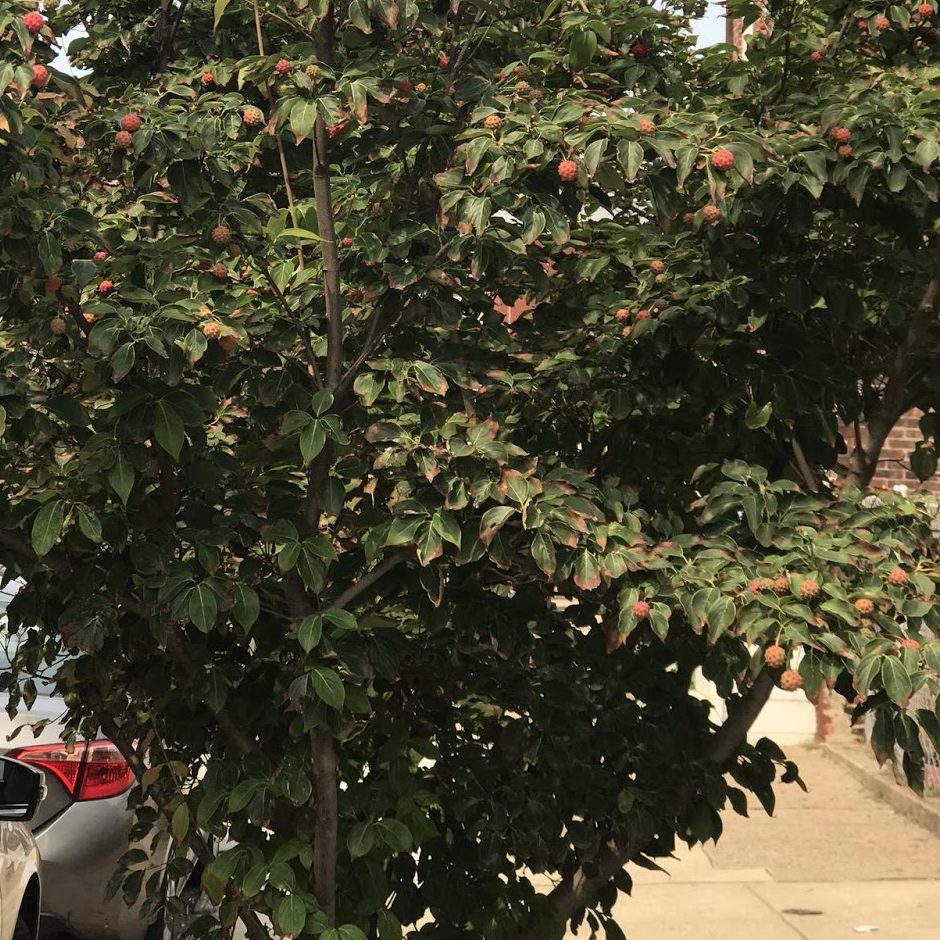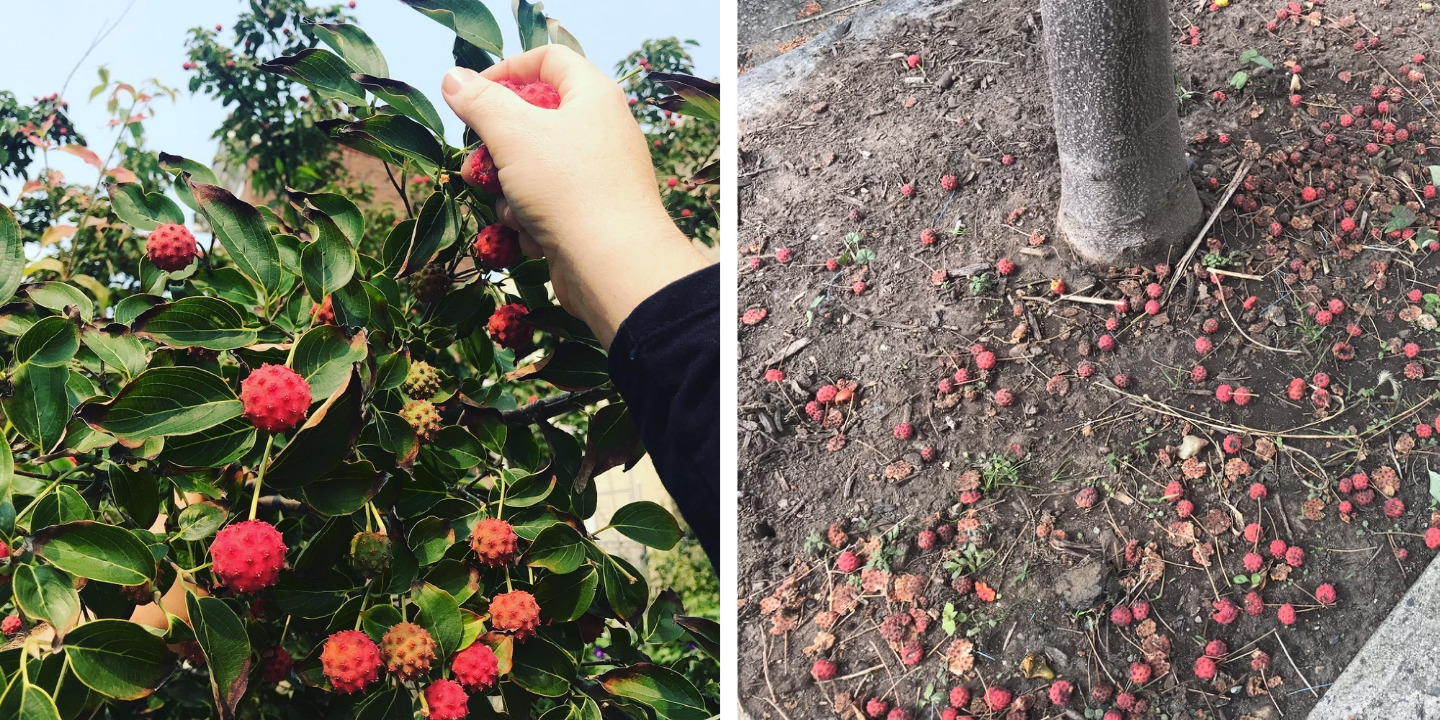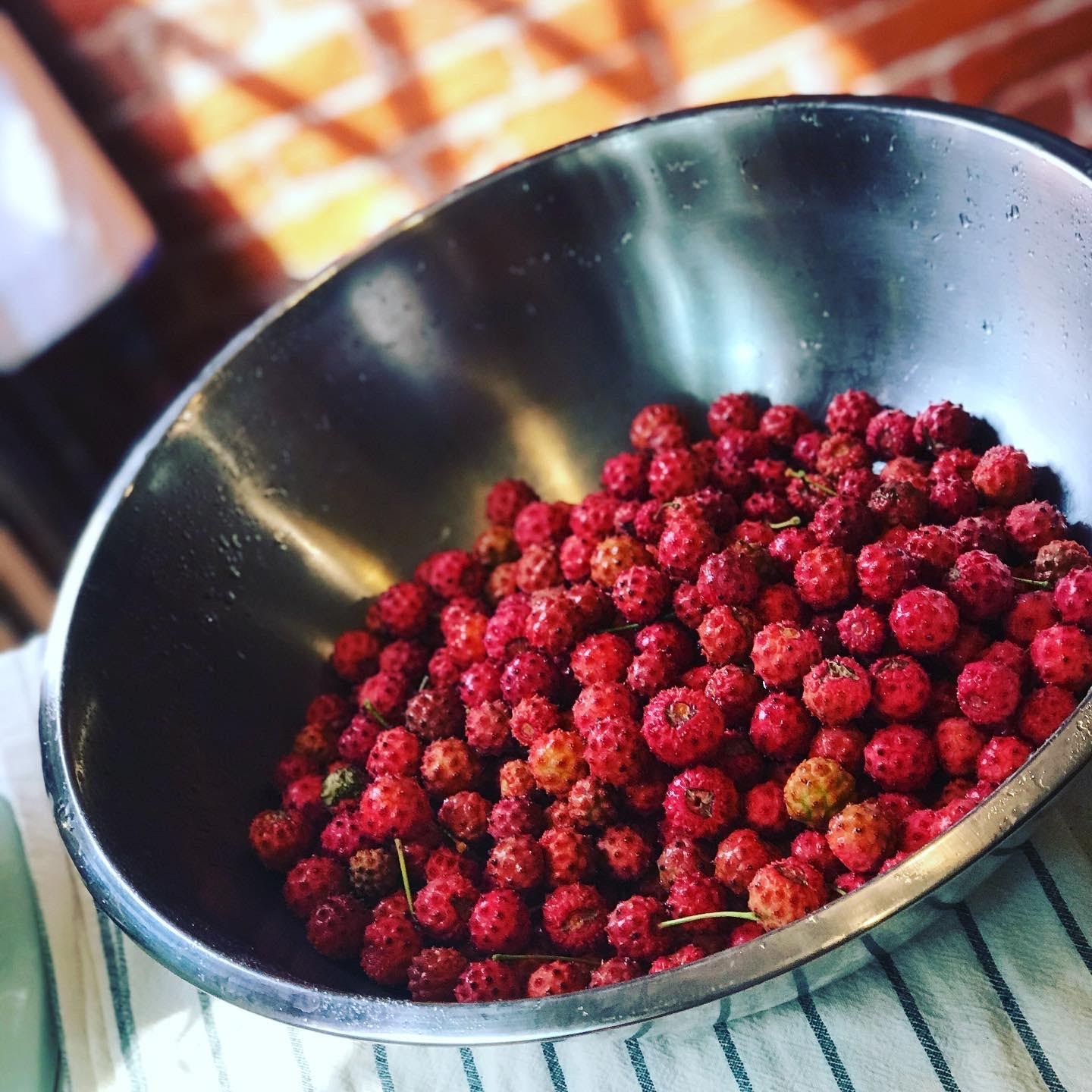It’s never the wrong time to step back and consider the multitude of common and uncommon fruits that grow almost without effort in our Mediterranean latitude (between 30° and 45° from the equator; Philadelphia is about 39° from the equator). This blog post features a tree that offers both edible flowers (in the spring) and fruit (in the fall), and which may have already caught your eye: the Kousa dogwood. Check your neighborhood- this tree is commonly planted around the city as an ornamental tree, but its tasty fruit mostly goes unpicked!
Photo credit: “Kousa dogwood, Harvard Yard” by Liz West is licensed under CC BY 2.0
Dogwoods or Cornaceae (Cornus), which reflects their family Latin name, are far more well known for their beautiful spring and early summer flowers than their edible fruits later in the year. However, certain varieties provide both, giving us the best of both worlds and the Cornus Kousa, aka Kousa Dogwood, Chinese Dogwood, or Japanese Dogwood, is one of those.

The Kousa Dogwood is native to large swaths of the Asian continent, most specifically Japan, Korea and China. The variety was reportedly brought to the United States in 1875, and has now naturalized (i.e. it’s not invasive) in and around New York state as well as many other parts of the United States. The mature tree reaches heights and widths between 15 to 30 feet and has oval leaves that end in a point approximately four inches long. The leaves turn a beautiful red to purple in the late fall, adding yet another attribute to its already impressive resume. The Kousa dogwood is easy to grow, being largely free of pest and and disease challenges and tolerant of partial shade.
Interestingly, its beautiful 4 pointed star-shaped flowers (white or pin) emerge in late spring approximately 3-4 weeks after native dogwood trees. Then, beginning in mid-September, the fruits (which resemble small green soccer balls with spikes), begin to redden, soften, and develop their sweet, cinnamony, persimmon-like flavor. As they begin to drop to the ground voluntarily, they may be harvested when the appropriate color. Fruits should be slightly soft when pressed with your fingers and a deep red color that is not yet purple.

Nutritionally, Dogwood fruits are thought to contain impressive amounts of anthocyanins that act as antioxidants. To best harvest the fruit, slice or break it in half, and scoop out the flesh in the center. Alternatively, many people harvest them as a snack and just suck out the flesh with their mouths. The skin is unfortunately tough and grainy and is unlikely to be palatable.

Uses
Dogwood fruits are primarily used for consumption in various ways although their color is lovely and could easily be incorporated into as a visual aesthetic. While the easiest way to eat a Dogwood fruit is to simply break it open and consume the meaty fruit on the inside as a snack, many people have begun to use the fruit in other ways, although some amount of fruit processing is often required.
- Dogwood fruit jam
What is great about this recipe is that it does very little of the food processing up front and just does a mesh strain later one. The flavors of dogwood fruit lend themselves incredibly to a complex and interesting jam. Highly recommend!
Recipe site here: https://harvestandyarn.wordpress.com/tag/dogwood/
- Incorporate into baked goods
Imagine a baked good without very many spices but still has flavors of cinnamon and fall. That’s exactly how these would turn out! Give them a whirl.
Recipe site here: http://www.lessnoise-moregreen.com/2013/09/foraging-for-kousa-dogwood-berries-and.html
- Make into Frozen yogurt or Ice Cream
Imagine eating the most fall-flavored froyo of your life. That’s how this should turn out! What’s great about this recipe is that any upfront work you do to get the flesh out of the dogwood fruit you can just save in the freezer and work it into froyo or ice cream later.
Recipe site here: http://www.edibleterrain.com/foraging-blog/2015/9/9/kousa-dogwood-fruits
- Ferment into wine or mead
Yes, you can turn almost any fruit into wine or mead but how amazing would these flavors be? For all you homebrewers or wine-makers out there, this recipe is definitely for you.
Recipe site here: https://tastycraze.com/n5-51497-How_to_Make_Jelly_and_Wine_from_Dogwood
With all these amazing uses, don’t get disheartened when the foraging season around Philadelphia seems to be coming to an end, keep an eye out for these Dogwood fruits. Until then, enjoy their beautiful flowers knowing that an even sweeter prize is just around the corner.
Sources
https://www.arborday.org/trees/treeguide/TreeDetail.cfm?ItemID=830
https://harvestandyarn.wordpress.com/tag/dogwood/
https://www.mortonarb.org/trees-plants/tree-plant-descriptions/kousa-dogwood
https://specialtyproduce.com/produce/Kousa_Dogwood_Berries_18370.php
https://www.missouribotanicalgarden.org/PlantFinder/PlantFinderDetails.aspx?kempercode=j910
http://hort.ufl.edu/database/documents/pdf/tree_fact_sheets/corkoua.pdf
https://plants.ces.ncsu.edu/plants/cornus-kousa/
https://www.mortonarb.org/trees-plants/tree-plant-descriptions/kousa-dogwood
https://pubmed.ncbi.nlm.nih.gov/16139847/ (Anthocyanins in Cornus alternifolia, Cornus controversa, Cornus kousa and Cornus florida fruits with health benefits)
Disclaimer
The Philadelphia Orchard Project stresses that you should not consume parts of any wild edible plants, herbs, weeds, trees, or bushes until you have verified with your health professional that they are safe for you. As with any new foods that you wish to try, it is best to introduce them slowly into your diet in small amounts.
The information presented on this website is for informational, reference, and educational purposes only and should not be interpreted as a substitute for diagnosis and treatment by a health care professional. Always consult a health care professional or medical doctor when suffering from any health ailment, disease, illness, or injury, or before attempting any traditional or folk remedies. Keep all plants away from children. As with any natural product, they can be toxic if misused.
To the best of our knowledge, the information contained herein is accurate and we have endeavored to provide sources for any borrowed material. Any testimonials on this web site are based on individual results and do not constitute a warranty of safety or guarantee that you will achieve the same results.
Neither the Philadelphia Orchard Project nor its employees, volunteers, or website contributors may be held liable or responsible for any allergy, illness, or injurious effect that any person or animal may suffer as a result of reliance on the information contained on this website nor as a result of the ingestion or use of any of the plants mentioned herein.
SAFETY PRECAUTION: While there are many plants which are helpful and beneficial for us to partner with, there are plants that are dangerous for us to consume or even to touch. It’s important that we take the necessary precautions – in a city space: avoid harvesting from places with pollution or runoff; avoid harvesting endangered plants; understand there are some plants used medicinally only in small doses vs some that can be eaten with relatively little concern. The most important thing is that you trust your body, go slow with incorporating any new plants into your diet!
This POP Blog Post was written by Wesley Goodman-Levy (@Phillyphorage on Instagram!).
SUPPORT US! If you found this entry useful, informative, or inspiring, please consider a donation of any size to help POP in planting and supporting community orchards in Philadelphia: phillyorchards.org/donate.